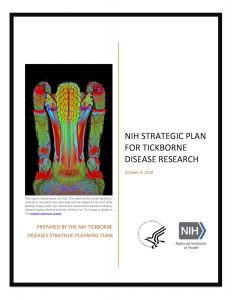
SHARE THIS ARTICLE:
NIH Releases Strategic Plan for Tick-Borne Disease Research

The NIH Strategic Plan for Tickborne Disease Research, October 9, 2019, is good news for everyone in the Lyme and tick-borne diseases community! The plan builds on the activities of the Department of Health and Human Services Tick-Borne Disease Working Group (TBDWG), which issued a 2018 report to Congress outlining research recommendations. Through inventories sent to government agencies to determine gaps in their research on tick-borne diseases (TBD), the Working Group uncovered the fact that NIH did not have a national strategy for TBD. The HHS TBDWG Report made the recommendation below in the November 2018 report:
Recommendation 8.1: NIH: Create an NIH tick-borne disease strategic plan, with public input during creation and implementation, to address tick-borne diseases, including all stages of Lyme disease. Include in the strategic plan the coordination of research funding across NIAID, NINDS, NIAMS, and NIMH to increase knowledge of pathogenesis, improve diagnosis, and develop and test new therapeutics for tick-borne diseases. Update every five years.
The LDA President, Pat Smith, served as a TBDWG member that wrote the 2018 report. She was reappointed this year for a second term as it develops the next report to Congress due December of 2020.
In developing this strategic plan, as recommended by the TBDWG Report, NIH sought input from the research and medical communities, patient advocacy groups, pharmaceutical industry, and the general public.
The Lyme Disease Association submitted input to the NIH on a strategy:
The newly released NIH plan focuses on five scientific priorities important for advancing research and development over the next five years.
- Improving fundamental knowledge of tickborne diseases, including the biology of tickborne pathogens; how they are transmitted to humans, evade the immune system, and spread within the body. Including determining the cause of persistent symptoms in some people infected with tickborne diseases, such as Lyme disease, and furthering the understanding of how tick-derived factors contribute to the establishment and severity of disease.
- Advance research to improve detection and diagnosis of TBDs. Improving detection and diagnosis of tickborne diseases by developing rapid diagnostic tests that can detect a pathogen both early and late in infection and distinguish between active and past infections. NIH will support the development of diagnostics capable of predicting treatment success and identifying human biomarkers of infection and persistent symptoms.
- Accelerate research to improve prevention of TBDs. The new plan also prioritizes the acceleration of research designed to prevent tickborne disease infection, including vaccines, and immune-based treatments, as well as strategies to reduce the transmission of tickborne pathogens to animal populations that serve as hosts.
- Focusing on research to develop new treatments for tickborne diseases and techniques to reduce disease complications.
- Prioritizing the development of tools and resources to advance tickborne disease research by improving scientists’ access to biological samples, tickborne disease genetic data, and supporting preclinical development of promising products.
NIH intends to expand collaborations across its institutes and centers to promote a multidisciplinary approach to tickborne disease research, answer complex biological questions and encourage the application of state-of-the-art technologies used successfully in a range of scientific disciplines.
NIH Strategic Plan for Tickborne Disease Research
NIH Strategic Plan News Release
Congressman Smith praises NIH announcement (TAPinto.net)
Congressman Smith press release on NIH Strategy
Note from LDA: tick-borne disease is generally spelled with a hyphen. NIH has chosen to leave out the hyphen in its report.





